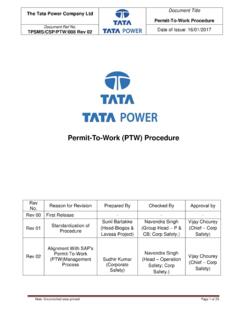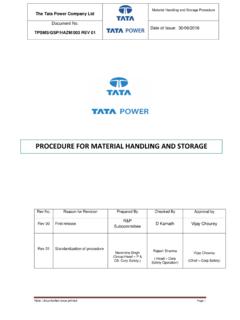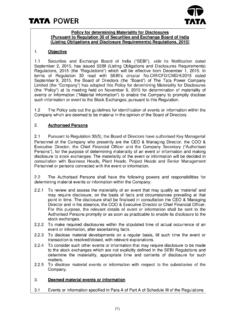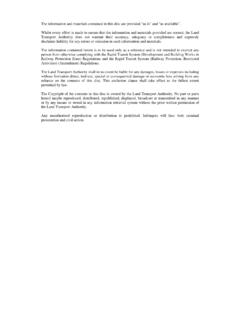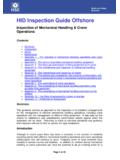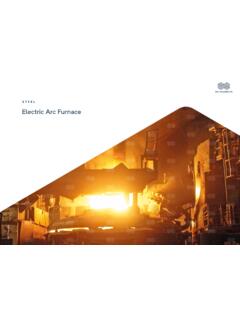Transcription of Heavy Equipment Movement Safety Procedure
1 Note: Uncontrolled once printed Page 1 of 24 The Tata Power Company Ltd Document Title Heavy Equipment Movement Safety Procedure Document Ref No. TPSMS/CSP/HEMS/005 Rev 01 Date of Issue: 01/01/2016 Heavy Equipment Movement Safety Procedure Rev No. Reason for Revision Prepared By Checked By Approval by Rev 00 First release R&P Subcommittee D Kamath Vijay Chourey Rev 01 Standardization of Procedure Arnav Mukherjee (Head - EMD & IMD Haldia) Navendra Singh (Group Head P Corp Safety .) Vijay Chourey (Chief Corp Safety ) Note: Uncontrolled once printed Page 2 of 24 The Tata Power Company Ltd Document Title Heavy Equipment Movement Safety Procedure Document Ref No. TPSMS/CSP/HEMS/005 Rev 01 Date of Issue: 01/01/2016 Contents Section Description Page No. OBJECTIVE 3 SCOPE 3 EXPECTED RESULTS 3 ACCOUNTABILITY & RESPONSIBILTIY 3 GLOSSARY/ DEFINITIONS 3 procedures 6 RECORDS 14 TRAINING & COMMUNICATION 11 VERIFICATION 15 EXCEPTION 15 REFERENCES 15 REVIEW 16 ATTACHMENTS/APPENDIX 16 - Annexure 1- Critical lift best practice for overhead crane Equipment .
2 17 - Annexure 2- Overhead crane pre-operational checklist (TPSMS/CSP/HEMS/005/FORM001) 19 - Annexure 3- crane Periodic inspection report format Mechanical Items (TPSMS/CSP/HEMS/005/FORM002) 21 - Annexure 4- Overhead crane Periodic inspection report format Electrical Items (TPSMS/CSP/HEMS/005/FORM003) 23 Note: Uncontrolled once printed Page 3 of 24 The Tata Power Company Ltd Document Title Heavy Equipment Movement Safety Procedure Document Ref No. TPSMS/CSP/HEMS/005 Rev 01 Date of Issue: 01/01/2016 1. OBJECTIVE: Objective of this Procedure is to cover the safe practices required for Heavy Equipment lifting and Movement . This Procedure is developed to establish mandatory requirements for practices to protect personnel from hazards associated with heave Equipment Movement activities.
3 2. SCOPE: This Procedure applies to all operating plants and project sites of Tata Power Group companies. 3. EXPECTED RESULTS: Manage jobs related to Heavy Equipment Movement being done safely. Control of incidents related to Heavy Equipment movements. Compliance to Regulatory requirements related to Heavy Equipment Movement . 4. ACCOUNTABILITY & RESPONSIBILITY: ACCOUNTABILITY: Concerned Division s Heads/Assets Custodian. RESPONSIBILITY: Concerned Engineer/s 5. GLOSSARY/ DEFINITIONS: Approver: Location Manager in charge of plant/dept. Authorized shall be as Per the permit to work Procedure . Attachment description - List type of slings; belts, wire ropes, chains, shackles etc. to be used to attach the load, if required make a simple sketch under lift description. Anti-two-blocking device - a device that, when activated, disengages all crane functions whose Movement can cause two-blocking.
4 Abnormal operating conditions Environmental conditions that are unfavorable, Harmful, or detrimental to the operation of a mobile crane ( , excessively high or low ambient temperatures, exposure to weather, corrosive fumes, dust-laden or Moisture-laden atmospheres, and hazardous locations). Competent Person - One who, by possession of a recognized degree, certificate, or professional standing and certified by government authority. Critical lift A lift using an mobile crane where, because of the characteristics and properties or travel path of the load, a hoist failure or loss of control of the load could result in a serious personal injury, serious environmental incident, serious process Safety incident, or significant disruption to operations. Capacity loading - It will be calculated by dividing the total weight with the safe workload at lift radius.
5 It shall not exceed 85%. For capacity loading above 85% a lifting plan is required. No capacity loading above 100% shall be allowed, equal to 90% of load test. If Safe Load Indicator is not installed the capacity loading shall not exceed 60%; if above a lifting plan is required. For lifting personnel the capacity loading must be below 50%. Note: Uncontrolled once printed Page 4 of 24 The Tata Power Company Ltd Document Title Heavy Equipment Movement Safety Procedure Document Ref No. TPSMS/CSP/HEMS/005 Rev 01 Date of Issue: 01/01/2016 Eccentric Load - Load center of gravity does not correspond to the geometrical center, an unevenly loaded container. In case of eccentric load for Heavy loads, say above 2 T, center of gravity should be calculated and lifting points defined accordingly.
6 For light loads the most practical is to determine the center of gravity by trial and error without lifting the load completely off the ground. Hazard Identification & Risk Assessment - Hazard Identification & Risk Assessment is to identify and evaluate the hazards, Risk and put controls measures for safe execution of activities. Hazard - Source or situation with potential for harm, something that can cause body injury / occupational illness, damage company property. HIRA - Hazard Identification and Risk Assessment Intended load = Dead load + Live load + wind load + Dynamic load. Job - A piece of physical work defined by time or other limits and that has a clear start and end point. JSA - Job Safety Analysis Job Safety Analysis: Job Safety analysis (JSA) is a Procedure which helps integrate accepted Safety and health principles and practices into a particular task or job.
7 In a JSA, for each basic step of the job, it is to identify potential hazards and to recommend the safest way to do the job. LEL - Lower Explosive Limit LOTO - Lock Out Tag out Load - Weight of load can be from Equipment data sheet, marking on packing, marking on pipe spool, calculation (add 15% allowance for inaccuracies) or weighing. Guessing the weight of the load is not allowed. crane user shall maintain record of how the weight was derived until the lift is successfully completed. Length x Width x Height (LxWxH) - Is required for bigger Equipment for deciding lifting radius and lifting height. For bigger surface, say above 25 m2, also wind loads need to be considered. For small pipe spools, valves etc. this data is not required. Lift Radius - Maximum horizontal distance between the point at which the center of crane rotation meets the ground and the vertical centerline passing through the load lifting attachment.
8 Lift Height - The height above the setting of the crane that the load must be lifted to. To derive at the boom height the length of hook, slings and load must be added as well as some free space above any Equipment the load will be slew over. Non Routine Job / Task: Where an SOP / SMP is not available or the conditions of the SOP / SMP have changed PPE - Personal Protective Equipment PTW - Permit to Work Periodic Inspection - Detailed Safety and maintenance inspection performed by a qualified person to verify compliance with the provisions of legal requirements. Note: Uncontrolled once printed Page 5 of 24 The Tata Power Company Ltd Document Title Heavy Equipment Movement Safety Procedure Document Ref No. TPSMS/CSP/HEMS/005 Rev 01 Date of Issue: 01/01/2016 Risk - The likelihood (probability) which can lead to potential negative consequences.
9 Risk Assessment - A systematic and structured process whereby hazards present in a workplace, or arising from workplace activity, are identified, risks assessed / evaluated, and decisions prioritized in order to reduce risks to acceptable levels. Rated load (capacity) - the maximum load designated by the manufacturer for which an individual hoisting system component is designed and built. Shall - Mandatory requirement Should - Optional requirement SHE - Safety , Health and Environment Severity - The level of consequence / harm of an event that could occur due to exposure to the hazard present. SWL - Safe working load Safe Workload at lift radius - Will be derived from the selected crane Load Chart for the calculated lift radius and boom length. Adjustment shall be done in relation to valid load test and only 85% of the load test value shall be considered as safe workload.
10 SLI - Safe Load Indicator, it is a system which cut-off all the unsafe crane operations if overloaded and anti two blocking comply. Safe access route - to the place for the crane set up shall be checked with SS or SFE. Ensure that ground can carry the load of the crane . If soil is soaked with water the loading capability is significantly reduced. Check for underground cables and pipes as well as vicinity to any above ground obstructions like fire hydrants, firewater valves and pits. Ensure that trailer bringing the load also has a safe access, not blocked by the intended set up of the crane . Standard lift - If load to be lifted weighs less than 15 ton, it is a standard lift. The crane user is required to complete mobile crane Planning & Risk Assessment Checklist . Two-blocking - The condition in which the lower load block or hook assembly comes in contact with the upper load block or boom point sheave assembly.




